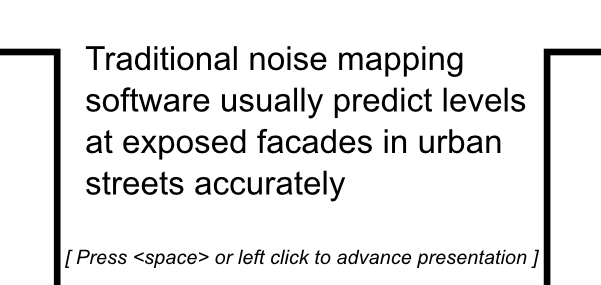Noise levels
Noise prediction
Prediction methods for noise levels from road and railway traffic have been used for a long time, and typically the methods in use today do a good job of predicting noise levels where they are high, i.e. at positions directly exposed to noise from busy streets. At positions shielded from direct exposure such as quiet courtyards or streets with no or very little traffic flow, the methods tend to underestimate the noise level. This is in principle due to
- More distant sources become important since no strong sources are nearby.
- Multiple reflections become more important; close to the source reflected sound paths become substantially longer than the direct path, but far from the source the direct and reflected path may be almost equal in length.
- Scattering by turbulence becomes important, the naturally occurring turbulence in the air scatters sound power down into the city landscape, which is important where the levels are low.
Many prediction methods can in principle take a high number of reflections into account, but this is computationally very time consuming since all possible ray paths must be identified. In order to make a more efficient method the QSide project made a large number of reference calculations using advanced numerical methods and used these results to create a simplified method that includes many reflections in only one calculation step.
The simplified method for shielded areas was designed to yield a contribution added on top of a calculation with a traditional method. It could be added to a "normal" noise map at all locations since the levels will be relatively low, and will not affect the level at exposed positions. At shielded positions the levels from the "normal" noise map will be too low, but adding the QSide contribution will correct that. The method is illustrated in the image below.

Figure 1. Example of adding calculations on quiet sides to an existing noise map.
There is a short slide show (10 images) that presents an overview
of the model which you can access by clicking the image below
References
- Technical report of QSide calculation model


